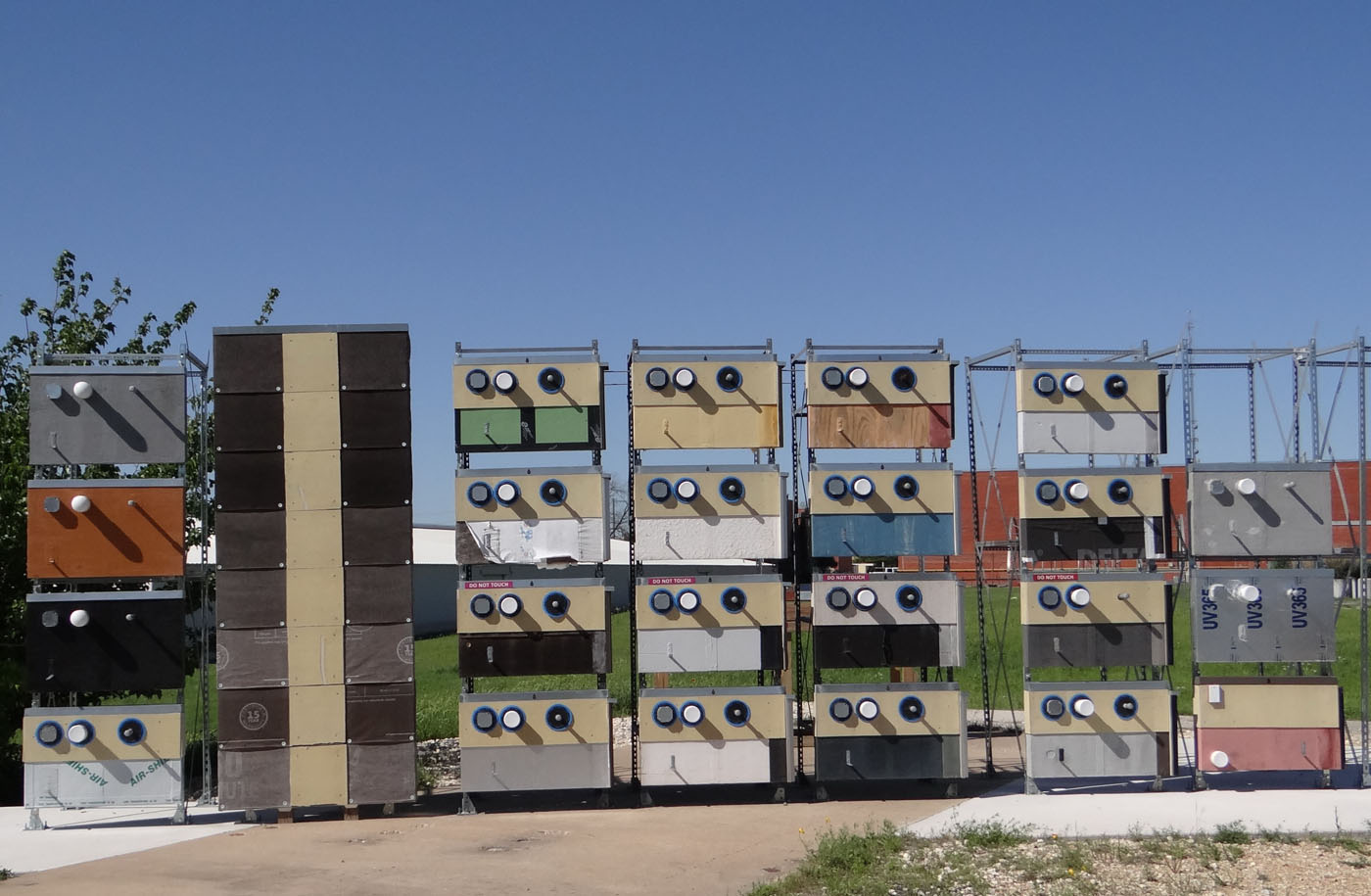Current Research and Testing
Stucco Materials and Details
10 stucco mixes were tested for thermal and shrinkage behavior Two walls were built consisting of 11 panels with different dimensions, aspect ratios, control joint assemblies, and weep screed details. Calliper readings are obtained regularly to evaluate shrinkage, temperature, and moisture content effects. See our publication, Improving Stucco Durability Using Moist Curing.
Building Sealants
61 sealant products were tested in accordance with Procedure C of ASTM C1589, Standard Practice for Outdoor Weathering of Construction Seals and Sealants. Silicone, urethane, and hybrid sealants have been exposed to weather since May 2014 (1st Set) and September 2015 (2nd Set) while their performance and durability are assessed under extension and compression cycles. See our publication, Durability of Elastomeric Sealants.
Construction Tapes and Flashings
18 tape and flashing products were tested in a method similar to ASTM D3654, Standard Test for Shear Adhesion of Pressure Sensitive Tapes. The products were tested on 7 substrates in a vast number of combinations, with additional variables introduced, to determine the performance of adhesive types and their suitability for different substrates. Also, long strips of tapes and flashings were installed at different temperature and humidity conditions to study their behavior, including the spontaneous development of “fishmouths”. Our article, “Durability of Construction Tapes and Flashings” by Anthony M. Garcia and Jorge M. Blanco, will be published in The Construction Specifier in December 2017.
Water Repellents
32 water-repellent products were tested to evaluate their initial effectiveness of preventing water absorption. The specimens are also exposed to weathering to evaluate their long-term effectiveness, to determine when a project would require re-application. Measurements are performed in general accordance with ASTM C642, Density, Absorption, and Voids in Hardened Concrete, and ASTM C67, Sampling and Testing Brick and Structural Clay Tile. See our publication regarding initial effectiveness, Testing the Test: Water Absorption With RILEM Tubes. We have not yet published our findings regarding long-term effectiveness.
Water-Resistive Barriers
31 water-resistive barrier products (sometimes called air barriers) and their accessory products were assembled onto mock-up panels and exposed to weather. The systems included building paper, felts, wraps, self-adhered sheets, and fluid-applied products as representatives of the more than 150 products currently on the market. Additional specimens of each product were tested for fastener sealability. See our publication of initial findings regarding detailing and UV stability, Durability of Water-Resistive Barriers. We have not yet published our findings regarding long-term effectiveness.
Corrosion Compatibility of Metals
5 metals commonly used in construction and 8 common fastener types were exposed in different combinations to observe the effect of corrosion with water run-down. The behavior observed cannot be predicted strictly according to the galvanic series; there are secondary effects based on which metal is at a higher elevation and which receives the ionized water. We have not yet published our findings regarding corrosion.
Other Topics and Publications
- Ensuring Balcony Durability by David H. Nicastro and Marie Horan
- Understanding Why Doors Leak by Adrian Gerard Saldanha and David H. Nicastro
- Investigating Sheathing Durability: Infrared Surveys in Hot Climates by Brett T. Fagan and Adrian Gerard Saldanha
- Ensuring Durability of Elastomeric Wall Coatings by David H. Nicastro and Patrick D. Gorman
- Durable Waterproofing for Concrete Masonry Walls: Redundancy Required by Robert M. Chamra, and Beth Anne Feero
- Bearing Pad Durability in Concrete Parking Garages by Doris Eichburg, Beth Anne Feero, and David Nicastro
- Durability of Brick Veneer: A Deeper Look at Masonry Anchors by Brett T. Fagan, Nickie M. Ramm, and Beth Anne Feero
- Bridging the Gap: Specifications for Durable Masonry Veneer Anchors by Robert M. Chamra, EIT, and Kyle R. Gagnon
- Different Applications, Different Anchors by Robert M. Chamra, EIT, and Kyle R. Gagnon


